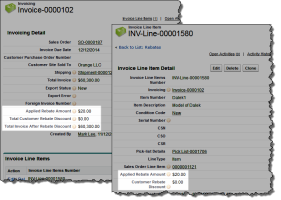- In the View section, select an appropriate list view from the drop-down list to go directly to that list page, or click Create New View to define your own custom list view. List views let you display a list of records that match specific criteria.
- In the Recent section, select an item from the drop-down list on the right to display a brief list of the top records matching that criteria. The choices are listed in the table that follows.
- From the list, you can click any invoice number to go directly to its detail.
| Recent Choice | Description | |
|---|---|---|
| Recently Viewed | The last 10 or 25 records you viewed, with the most recently viewed item listed first. This list is derived from your recent items and includes records owned by you and other users. | |
| Recently Created | The last 10 or 25 records you created, with the most recently created item listed first. This list only includes records owned by you. | |
| Recently Modified | The last 10 or 25 records you updated, with the most recently updated item listed first. This list only includes records owned by you. |
SCM invoices are created to record the products, quantities, and agreed prices for goods or services that you have already provided to a buyer. An invoice indicates that, unless paid in advance, payment is due by the buyer to the seller, according to the agreed terms.
An invoice contains one or more line items that determine the goods and services that you are requesting payment for.
Invoice Line Item Types
The available invoice line item types are the following:
|
Invoice Line Item Type |
Description |
|---|---|
| Deposit | Used for deposits requested from the customer. |
| Drop Ship Item | Used for items that do not belong to your inventory and are directly sold from the supplier (a purchase order is issued to the supplier to satisfy the sale). |
| Freight | Used for freight charges. |
| Item | Used for items that are defined in the Item Master. |
| Labor | Used to invoice labor. |
| Miscellaneous | Used for miscellaneous charges. |
| Tax | Used to add tax. |
| Virtual Kit Item | Used for items that are part of a virtual kit. |
Invoicing Workflow
The creation of SCM invoices is automatically triggered by the actions you perform as part of your order fulfillment process. In most cases, invoices are automatically generated when a sales order is approved so that you do not need to create them manually. However, only item lines are considered and included in the generated invoices. If you want to invoice drop ship lines or lines for intangible items (such as accounting lines), you will need to use the Review Invoice action available on the sales order. For more information, see the invoicing workflow described below and Reviewing an Invoice.
The invoicing workflow is usually as follows:
- After a sales order is approved, the system automatically creates an invoice record based on the sales order's information. Only item lines are considered and included in the invoice. If the sales order contains only drop ship lines or lines for intangible items, such as accounting lines, no invoice record is created. Make sure that the created invoice record is correct.
- Review the invoice using the Review Invoice button available on the sales order page. This is required only if you need to invoice drop ship lines or lines for intangible items (because these are not considered by the process that automatically generates invoices after sales orders are approved).
- Export the invoice to Accounting so that it can be posted. The invoice is exported as a sales invoice.
Credited Invoices and Voided Invoices
In SCM you can credit and void invoices.
- Crediting an invoice: You can credit an invoice to rectify any errors made on the invoice. Credit invoices may also be created when a customer wishes to return previously purchased items. Crediting an invoice creates a credit invoice record and enables you to select the specific lines you want to credit and the credit amount for each of the selected lines. This allows for a partial credit of the source invoice. For more information on customer returns and credit invoices, see Enhanced Customer Returns and Customer Return Credits.
- Voiding an invoice: You can void an invoice to make it invalid. This retains the invoice record in the system with a status of "Voided" and automatically creates a credit invoice record with a credit invoice line for each of the lines in the source invoice. Unlike the crediting process, the voiding process only allows for a full credit of the source invoice total. For more information about credit invoices, see Credit Invoices.
Rebates
When a sales order is shipped, rebates that have been applied to the sales order are included in the invoice along with the rebate discount to be passed to the customer.
